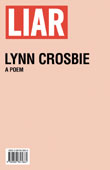 I regularly read Lynn Crosbie’s column in Saturday’s Globe and Mail, often accompanied by a dictionary to decipher the assorted words she uses that do not reside within my personal lexicon. Several weeks ago, she published an excerpt from her poem “Liar,”* the full-length version spanning 150 pages, about a break-up with a boyfriend.
I regularly read Lynn Crosbie’s column in Saturday’s Globe and Mail, often accompanied by a dictionary to decipher the assorted words she uses that do not reside within my personal lexicon. Several weeks ago, she published an excerpt from her poem “Liar,”* the full-length version spanning 150 pages, about a break-up with a boyfriend.Now Crosbie tends to be caustic at the best of times, sharing her acidulous views on cultural trends in North America and deconstructing the insidious celebrity tabloids that now seem to stretch beyond the sphere of cheap newsprint, stapled and displayed at grocery store checkout aisles, to the glaring magazine aisles at reputable booksellers.
 However, the excerpts that I read from “Liar” show an even more rancorous individual, deeply hurt and seething from the humiliation she experienced at her partner’s betrayal. (It is a fallacy to assume that all writing is based on personal experience, however Crosbie has revealed in interviews that “Liar” is based on her own experience of an infidelity and subsequent break-up.) From Crosbie’s choler comes prolific and magnificent lines of poetry. Her images are striking and her words are carefully chosen.
However, the excerpts that I read from “Liar” show an even more rancorous individual, deeply hurt and seething from the humiliation she experienced at her partner’s betrayal. (It is a fallacy to assume that all writing is based on personal experience, however Crosbie has revealed in interviews that “Liar” is based on her own experience of an infidelity and subsequent break-up.) From Crosbie’s choler comes prolific and magnificent lines of poetry. Her images are striking and her words are carefully chosen.And all this begs the question, would she be capable of such quality if she hadn’t plumbed the depths of her sadness?
Although I consider myself a writer, I haven’t written a poem of any merit since my early 20s, a time when my emotions existed a little closer to the surface. And most of my poetry was about boys and how they had hurt me.
So is Ms. Crosbie an artist because she is tortured? Was Virginia Woolf a cutting-edge novelist and Sylvia Plath a celebrated poet, because they felt their depression to their very core? Do you have to be hurt to write good poetry?
Many artists say that they write/paint/create because they “have to.” Honoré de Balzac said: “I am a galley slave to pen and ink,” meaning that he was compelled to write. Forms of art can be seen as coping mechanisms - just as the non-artists among us go to therapists, drink vast amounts of alcohol or take long runs to deal with the torment in their lives, artists create in order to deal with their feelings.
And it seems that many artists seem to have more intense feelings, especially of depression, than the average person. Lots of poets and musicians have suffered from various mental illnesses and addictions that have fuelled their creativity.**
Regardless of what motivates writers to write or musicians to compose, or artists to paint, one thing remains uniform: when shared with others, artists' creations provide a connection of feelings across human experience. There are parts of Crosbie’s poem that resonate with my experience, just as there were parts of “Mrs. Dalloway” that resonated with millions of readers or, according to the song “Semi-Charmed Kind of Life” by Third Eye Blind: “The four right chords could make me cry.”
A piece of art provides a link of experience which, despite feelings of loneliness and desperation during its creation, says to its beholder, “you are not alone.”
*
**
No comments:
Post a Comment